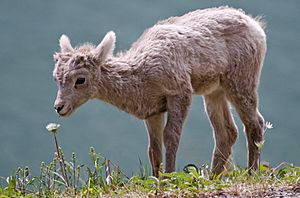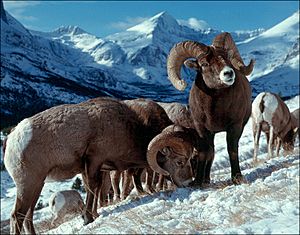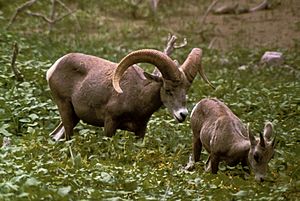Bighorn sheep facts for kids
Quick facts for kids Bighorn sheep |
|
|---|---|
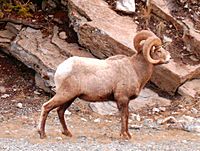 |
|
| Male (ram) | |
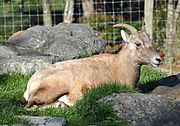 |
|
| Female (ewe) | |
| Conservation status | |
| Scientific classification | |
| Kingdom: | |
| Class: | |
| Order: | |
| Family: | |
| Subfamily: | |
| Genus: | |
| Binomial name | |
| Ovis canadensis |
|
The bighorn sheep (Ovis canadensis) is a type of sheep that lives in North America. They are called "bighorn" because of their huge horns. These horns can weigh as much as 30 pounds (14 kg). The sheep themselves can weigh up to 300 pounds (140 kg). Scientists have found there are three kinds of bighorn sheep. One of these kinds is an endangered species.
Bighorn sheep originally came from Siberia. They crossed into North America over a land bridge called Bering land bridge. Their population grew to millions. They even became part of the Native Americans' mythology. But by 1900, their numbers dropped to only a few thousand. Many groups, like the Boy Scouts of America, have helped their population grow again.
Contents
What Do Bighorn Sheep Look Like?
Bighorn sheep get their name from the large, curved horns that male sheep, called rams, have. Female sheep, called ewes, also have horns, but they are shorter and not as curved. Their fur can be light brown, grayish, or dark chocolate brown. They have a white patch on their rear and white on the backs of their legs.
Male bighorns usually weigh between 130 and 315 pounds (58-143 kg). They stand about 35 to 41 inches (90-105 cm) tall at the shoulder. From nose to tail, they are about 5 to 6 feet (1.6-1.85 meters) long. Females are smaller, weighing 75 to 200 pounds (34-91 kg). They are about 30 to 35 inches (75-90 cm) tall and 4 to 5 feet (1.28-1.58 meters) long.
Male bighorn sheep have very strong skulls and horns. These help protect their brains when they crash heads. The horns of a male can weigh up to 30 pounds (14 kg). This is as much as all the other bones in their body!
Where Bighorn Sheep Live and How They Survive
Their Home and What They Eat
Bighorn sheep that live in the Rocky Mountains and Sierra Nevada prefer cooler mountain areas in Canada and the United States. Desert bighorn sheep live in the hot deserts of the Southwestern United States and Mexico.
Bighorn sheep usually live in high mountain meadows, grassy slopes, and rocky areas near cliffs. They cannot move easily through deep snow. So, they like drier slopes where there is less than 60 inches (150 cm) of snow each year. In winter, they usually move to lower places where it's not as cold.
Bighorn sheep can get sick from diseases carried by domestic sheep, like pneumonia. They can also get hurt by falling rocks or falling off cliffs. Young bighorn sheep, called lambs, are often hunted by coyotes, bobcats, lynxes, and golden eagles. Older bighorns are hunted by bears, wolves, and especially cougars. Cougars are very good at hunting them in rocky places.
Bighorn sheep are important because they show how healthy the land is. If bighorn sheep are doing well, it often means the environment is healthy. They also provide food for hunters.
Bighorn sheep mostly eat grasses and shrubs. They also look for minerals at natural salt licks.
How Bighorn Sheep Live Together and Have Babies
Bighorn sheep live in large groups. Before the mating season, male rams fight to decide who is strongest. This helps them decide which males get to mate with the females. During this time, you can often hear their horns clashing loudly. Females also have a social order, which is usually based on their age.
Female bighorn sheep are pregnant for about six months. In cooler areas, most babies are born in May. Usually, a mother has one lamb, but sometimes two. Lambs born earlier in the season have a better chance of surviving. Newborn lambs weigh about 8 to 10 pounds (3.6-4.5 kg). They can walk just a few hours after they are born! They stop drinking their mother's milk when they are four to six months old. Male bighorn sheep usually live for 9 to 12 years, while females can live for 10 to 14 years.
Health Challenges
Many bighorn sheep groups in the United States often get sick with pneumonia. This disease usually comes from bacteria carried by domestic sheep. Once the disease starts, it can spread very quickly. Sometimes, it kills up to 90% of the bighorn sheep in a group. For several years after, many lambs might also get pneumonia. This makes it hard for the population to grow.
Bighorn Sheep and Humans
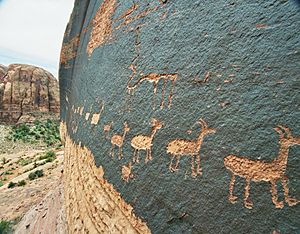
Two hundred years ago, there were many bighorn sheep across the western US, Canada, and northern Mexico. Some people think there were over 2 million of them. But by 1900, hunting, competition from farm animals, and diseases caused their numbers to drop to just a few thousand.
After World War II, programs to bring them back, create national parks, and reduce hunting helped the bighorn sheep population recover. Also, fewer domestic sheep were kept near bighorn habitats.
Scouting Efforts
In 1936, the Arizona Boy Scouts started a big effort to save the bighorn sheep. A conservationist named Major Frederick Russell Burnham helped them. He noticed there were fewer than 150 bighorn sheep left in Arizona. He wanted the Boy Scouts to help save this animal.
Many important people in Arizona joined the effort. They held a "save the bighorns" poster contest in schools. The winning picture was made into neckerchief slides for 10,000 Boy Scouts. Talks were given in schools and on the radio. Other groups, like the National Wildlife Federation, also helped.
These efforts led to the creation of two special areas for bighorn sheep in Arizona: Kofa National Wildlife Refuge and Cabeza Prieta National Wildlife Refuge. On January 18, 1939, over 1.5 million acres (6,000 square kilometers) of land were set aside. Workers also built waterholes in the mountains for the sheep. Today, the desert bighorn sheep is the official mascot for the Arizona Boy Scouts.
In Culture
Bighorn sheep were very important to the Apsaalooka (Crow) people. The Bighorn Mountain Range was a central part of their land. There is a legend about a man who was saved by bighorn sheep after being pushed off a cliff. He took the name of their leader, Big Metal. The sheep gave him power, wisdom, sharp eyes, sure-footedness, strength, and a strong heart. Big Metal returned to his people with a message: the Apsaalooka people would survive as long as the river from the mountains was called the Bighorn River.
People hunt bighorn sheep for their meat and horns. The horns are used in ceremonies, as food, and as hunting trophies. Tourists also like to see bighorn sheep in their natural homes.
The Rocky Mountain bighorn sheep is the official mammal of Alberta, Canada. It is also the state animal of Colorado in the United States. It is even part of the symbol for the Colorado Division of Parks and Wildlife.
Early explorers like Lewis and Clark saw many bighorn sheep. They wrote about them in their journals. They also noted that the Shoshone people used bighorn sheep horns to make bows. The Bighorn River and its smaller branch, the Little Bighorn River, are named after these animals. The Battle of the Little Bighorn was also named after the river.
Images for kids
See also
 In Spanish: Musmón para niños
In Spanish: Musmón para niños



